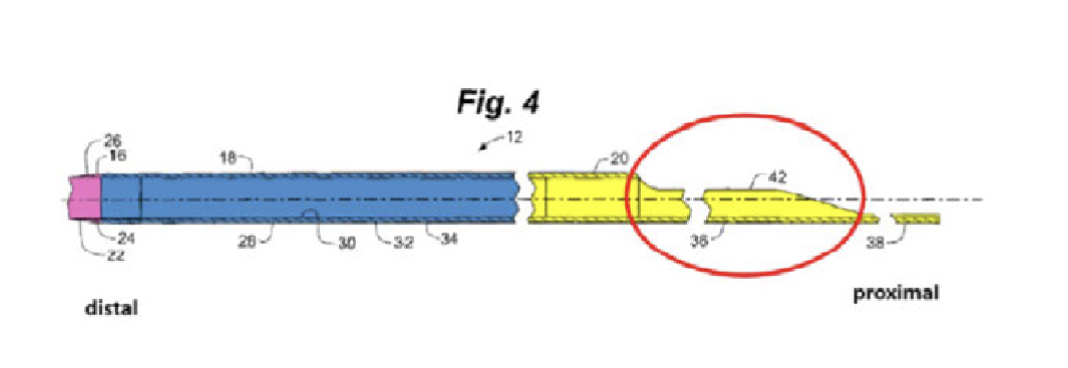“The fact that a competitor copied the patentee’s invention, rather than one within the public domain, is probative of nonobviousness because it suggests the competitor saw value in the invention that he could not achieve without copying.” – CAFC
 In two separate precedential decisions authored by Chief Judge Moore today, the U.S. Court of Appeals for the Federal Circuit (CAFC) delivered victory for Teleflex Innovations, S.À.R.L. when it upheld Patent Trial and Appeal Board (PTAB) rulings that found Medtronic, Inc. had failed to prove Teleflex’s patent claims for catheter technology used in interventional cardiology procedures unpatentable.
In two separate precedential decisions authored by Chief Judge Moore today, the U.S. Court of Appeals for the Federal Circuit (CAFC) delivered victory for Teleflex Innovations, S.À.R.L. when it upheld Patent Trial and Appeal Board (PTAB) rulings that found Medtronic, Inc. had failed to prove Teleflex’s patent claims for catheter technology used in interventional cardiology procedures unpatentable.
The court issued a related decision last month, authored by Judge Lourie, also finding for Teleflex. Chief Judge Moore joined Lourie’s opinion, while Judge Dyk dissented.
Today’s decisions involve six inter partes review (IPR) proceedings and five patents in total.
In Case: 21-2357, the CAFC affirmed the PTAB’s rulings on the claims at issue in IPR2020-00127, IPR2020-00130, IPR2020-00136. The patents challenged in those proceedings were U.S. Patent Nos. 8,048,032; RE45,380; and RE45,776.
In Case: 21-2359, the court affirmed the issues on appeal from the Final Written Decisions in IPR2020-00129, IPR2020-00134, IPR2020-00138, which involved the ‘380 patent and well as RE45,760; and RE47,379.
The cases involve Teleflex’s guide extension catheters, introduced in 2009, which were marketed as the GuideLiner V1, GuideLiner V2, and GuideLiner V3 (collectively, the GuideLiner). The products were very commercially successful and soon followed by competing products, including Medtronic’s Telescope product, introduced in 2019.
Medtronic filed the IPR petitions in 2019, arguing that the claims at issue in Case: 21-2357 would have been obvious over U.S. Patent No. 5,439,445 (Kontos) and that the challenged claims in Case: 21-2359 would have been obvious over U.S. Patent No. 7,604,612 (Ressemann), in addition to a number of secondary references cited across the IPRs.

Source: CAFC opinion
The PTAB ultimately found some claims unpatentable and others not unpatentable, and also granted Teleflex’s motions to amend certain claims of the ’032, ’380 and ’379 patents and determined the amended claims were not unpatentable. Medtronic appealed the Board’s finding that it failed to prove the “Side Opening”, “One-French”, and “Double-Incline” Claims would have been obvious in Case: 21-2357 and that it failed to prove the “One-French” and “Double-Incline” Claims would have been obvious in Case: 21-2359. It additionally challenged the PTAB’s decision to grant Teleflex’s motion to introduce substitute claims.
Nexus and Evidence of Nonobviousness
In countering Medtronic’s argument in the IPRs at issue in the 2357 case, Teleflex in part provided evidence of objective indicia of nonobviousness, which the Board relied upon to find that Medtronic had failed to establish the Side Opening Claims would have been obvious, despite a “close prima facie case.” The PTAB found that Teleflex’s objective evidence had a nexus with the Side Opening Claims and that this “’strong objective evidence of nonobviousness’ overcame the close prima facie case.”
On appeal, Medtronic claimed the Board had committed a host of legal errors in its analysis, but the CAFC disagreed and affirmed. Addressing Medtronic’s Nexus arguments, the court said, “it is undisputed that a presumption of nexus applies in this case because Teleflex’s ‘asserted objective evidence is tied to a specific product [i.e., the GuideLiner] and that product is the invention disclosed and claimed’ by the patents-in-suit.”
While Medtronic could have rebutted this presumption by showing that Teleflex’s features were known, as a combination in the prior art, the CAFC agreed with the Board’s assessment that Medtronic showed every element of the Side Opening Claims “was individually known in the prior art but correctly concluded this did not preclude nexus where the evidence was ‘tied to the combination of features as a whole’ and the combination was not previously known.”
Copying
The Board also found in the 2357 case that Medtronic copied the GuideLiner in developing its product, the Telescope. The PTAB said the products have substantially similar designs, and despite Medtronic’s view that “evidence of substantial similarity is ‘irrelevant’ because it does not show that Medtronic ‘actually copied’ the GuideLiner when developing the Telescope,” the CAFC explained that “[t]he fact that a competitor copied the patentee’s invention, rather than one within the public domain, is probative of nonobviousness because it suggests the competitor saw value in the invention that he could not achieve without copying.” While the court has held that copying must be supported by “actual evidence of copying efforts as opposed to mere allegations regarding similarities between the accused product and a patent,” the decision said “[w]e have never held…that copying cannot be established through evidence of access to and substantial similarity with a patented product.”
The court further explained in the 2357 case that the Board’s findings on the objective indicia of nonobviousness were entitled to deference, although the CAFC reviews the ultimate question of obviousness de novo. The court was particularly persuaded, like the PTAB, by the Board’s finding that multiple competitors copied the GuideLiner in developing their own guide extension catheters.
In Case: 21-2359, the CAFC rejected Medtronic’s arguments that a skilled artisan would have been motivated to modify the prior art, Ressemann, by removing its sealing balloons and creating a device similar to the GuideLiner. Teleflex said this would render the device in Ressemann inoperable, and the CAFC agreed. The court explained that Medtronic’s argument “is premised on an assertion of fact contrary to the
Board’s findings, namely that Ressemann is suitable for procedures that do not employ occlusive sealing balloons.” Medtronic argued that the PTAB’s holding was inconsistent with Intel Corp. v. Qualcomm Inc., which said that the “’intended purpose of [a reference] does not control’ the obviousness inquiry.” Quite to the contrary, said the court, Intel “did not hold…that a proposed modification’s destruction of a device’s primary purpose is always legally irrelevant to obviousness. Such a conclusion is equally at odds with common sense and gives in to the very hindsight bias the obviousness inquiry is designed to avoid.”
Substitute Claims/Written Description
In both cases, the CAFC also found unpersuasive Medtronic’s arguments that Teleflex’s substitute claims (which all claim priority to the same original application) lacked adequate written description, specifically that “the Substitute Claims encompass catheters with side openings separate from the substantially rigid segment, whereas the written description only describes side openings that were part of the substantially rigid segment.“
In the 2359 case, the court explained that the Board “identified written disclosures and figures it found provided the necessary support” and that “written description requires only that a skilled artisan would reasonably conclude, based on the patent’s disclosures and the knowledge of a person skilled in the art, that the applicant possessed catheters in which the side opening could be located outside the rigid segment.” Since the Board provided sufficient support for this determination, and since “if the precise location of the side opening was not an element of the invention, claims that do not recite the location as a limitation are not “unsupported by the specification even though [they] would be literally infringed by undisclosed embodiments,” the CAFC affirmed the PTAB’s analysis and said Medtronic had failed to show legal error.
Image Source: Deposit Photos
Image ID:103763568
Copyright:bigfatnapoleon

![[IPWatchdog Logo]](https://ipwatchdog.com/wp-content/themes/IPWatchdog%20-%202023/assets/images/temp/logo-small@2x.png)

![[Advertisement]](https://ipwatchdog.com/wp-content/uploads/2024/04/Artificial-Intelligence-2024-REPLAY-sidebar-700x500-corrected.jpg)
![[Advertisement]](https://ipwatchdog.com/wp-content/uploads/2024/04/Patent-Litigation-Masters-2024-sidebar-700x500-1.jpg)

![[Advertisement]](https://ipwatchdog.com/wp-content/uploads/2021/12/WEBINAR-336-x-280-px.png)
![[Advertisement]](https://ipwatchdog.com/wp-content/uploads/2021/12/2021-Patent-Practice-on-Demand-recorded-Feb-2021-336-x-280.jpg)
![[Advertisement]](https://ipwatchdog.com/wp-content/uploads/2021/12/Ad-4-The-Invent-Patent-System™.png)






Join the Discussion
One comment so far.
Pro Say
June 5, 2023 07:03 pmBravo CAFC and PTAB. Bravo.
More like these, please.
American innovation desperately needs more like these.